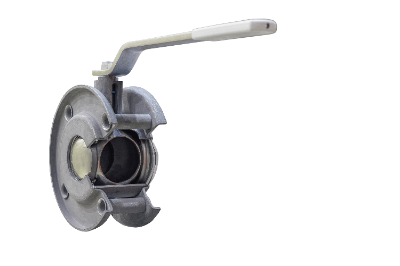What Is a Ball Valve?
 A Ball Valve is a valve with a ball-shaped plug. They are operated either fully open or fully closed. It is not suitable for flow adjustment by opening.
A Ball Valve is a valve with a ball-shaped plug. They are operated either fully open or fully closed. It is not suitable for flow adjustment by opening.
However, since the internal flow path is the same as the pipe diameter, there is almost no pressure loss. For this reason, the ball valve is often used in locations where there is no problem with only fully open or fully closed control.
Corrosion resistance can also be ensured by changing the material.
Uses of Ball Valves
Ball valves are used in a wide range of applications, from consumer products to industrial applications.
For consumer products, ball valves are used for gas stove valves. They are also used in water supply valves.
In industrial applications, they are used in many situations due to their extremely low pressure drop and high shut-off performance. They are especially used in water and gas lines.
They are also used in lines conveying food solids and drainage lines containing sludge, since there are no obstructions in the flow path when fully open.
By applying a PFA coating to the inside or manufacturing with PVC or PTFE, it can also be used in chemical lines such as hydrochloric acid.
Principle of Ball Valve
The structure of a ball valve is very simple. A ball-shaped valve piece with a cylindrical hole is contained inside, and the valve is opened and closed by rotating the valve ball 90°.
In general, the direction of the handle is fully closed when it is perpendicular to the flow path and fully open when it is parallel to the flow path. Since the direction of the handle is easy to distinguish, there is no need to worry about mishandling.
However, due to its structure, it is not suitable for flow control. PTFE is often used to seal the valve plug.
It is self-lubricating and can be used for many fluids, but cannot be used under high temperatures such as steam lines. Under high temperature and high pressure, heat-resistant materials or metal gaskets should be used.
Since the contact area between the gasket and the ball is large, the larger the bore size of the valve ball, the greater the opening and closing torque. 100 A or more will require a considerably large torque, making it difficult to open by hand.
Other Information on Ball Valves
1. Flow Direction of Valve Balls
There are several types of valves, such as Gate Valves, Check Valves, Globe Valves, and Ball Valves. Each type has different characteristics.
Gate valves and ball valves do not control flow rate. Globe valves can control the flow rate, but the pressure loss is higher. Each valve also has its own restrictions regarding the direction of flow.
Check valves are installed to prevent backflow, so they flow in one direction and not in the opposite direction. Globe valves are also basically one-directional. Depending on the structure, they may also be used in the reverse direction. Gate valves and ball valves basically have no restrictions on flow direction.
Valve ball valves operate by turning the handle 90° to stop the fluid. Because of its simple operation, it can open and close more rapidly than a gate valve. However, care must be taken to avoid water hammer.
In general, the handle is considered open when it is parallel to the piping.
2. Full Bore of Ball Valves
There are two types of valve ball valves: reduced bore and full bore. Reduced bore valves have a valve plug opening smaller in diameter than the inside diameter of the piping. In the full bore, the valve plug opening is the same diameter as the pipe bore.
The pressure loss of a full bore is smaller than that of a reduced bore. Therefore, when designing piping, pressure loss calculations are performed to determine whether to use a reduced bore or a full bore. If there is a pressure drop problem due to a large pressure drop, a full bore will be used.